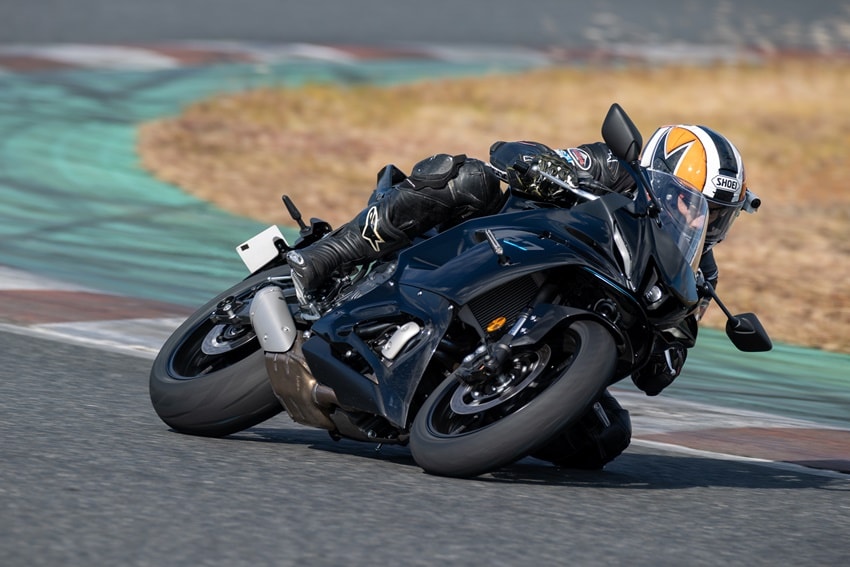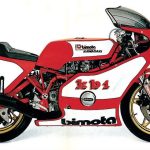Photo by Takayuki Minami
A test ride of the Yamaha YZF-R7 was held for the media in Japan. Kenny Sagawa brings you his best report.
I want to use up all the performance and drive cool.
The R7 is a new-generation supersport. According to Yamaha's research prior to development, the key phrase that emerged as the basic mindset of riders looking for a supersport (SS) was "I want to ride cool. They want an SS that they can ride in a cool way, including the styling."
On the other hand, today's 1000cc class straight-four supersports are over-spec, and some say even the 600cc class is too hard. The R7 is the embodiment of a new SS that allows even ordinary riders to enjoy driving to the fullest without feeling overwhelmed by its performance.
This is a machine that allows you to open the throttle without hesitation, without being afraid of the power, and to improve your skills while enjoying the corners. The aim was to create an SS with enough nostalgia to be enjoyed not only on circuits but also on winding roads. In addition, the design incorporates the YZF styling, which is connected to the R1 and R6, and the DNA of the "R" series, which is instantly recognizable as the SS. Another key point is that the price has been kept at a reasonable level that makes it easy for even entry-level riders to afford.
Optimized for SS by utilizing the qualities of the MT-07
The R7's concept is that of a Fun Master of Supersports, meaning a supersport that is the ultimate in driving fun. Although it doesn't have overwhelming performance or electronic control, the R7 offers the pure joy of driving and the satisfaction of honing your skills.
To meet these requirements, the MT-07 was the perfect choice. Originally, the MT-07 was a nimble sports naked with a liquid-cooled in-line two-cylinder engine (called the CP2 engine by Yamaha) of the torque-filled, easy-to-handle crossplane concept mounted on a supple steel frame.
In fact, racing on two-cylinder SSs is popular overseas, and full cowl customization based on the MT-07 has become the norm.
Against this backdrop, the R7 is an all-new model, but the engine, frame, and other key components are shared with the MT-07 to reduce costs. However, the suspension, including the front and rear suspensions, has been optimized to deliver a SS-like ride.
Specifically, the fork brackets have been strengthened and the swingarm pivot has been reinforced with a center brace, and the fork offset and rear suspension link ratio have been changed to improve agility and straight-line stability. The fork offset and rear suspension linkage ratio have been changed to improve the motorcycle's agility and straight-line stability, and the front/rear load distribution has been moved closer to the front for sportier handling. The full cowl, separate handlebar and back step give the SS a unique riding position.
In other words, this model is a reconfiguration of the MT-07 with the basic essence of the SS while utilizing its outstanding qualities.
Easy to ride and comfortable to the body
With its iconic front M-ducts and well-proportioned horizontal design, it has the same imposing supersport look as the R1 and R6. The ride position is similar to that of the R6, with a lower steering wheel position and a more forward lean than the R25. With a seat height of 835mm, the R25 is a little high in terms of height, but thanks to the slim body of the R series, it has good footing.
Photo by Takayuki Minami
When the engine is started, the CP2 engine wakes up with the crisp beat of the 270 degree crank and is very energetic. When the light clutch is connected and the accelerator is opened, a burst of torque gushes out and pushes the vehicle forward. Acceleration is strong, and although there is a sense of pulse, it is smooth with no vibration. The handling is straightforward and nimble, and there's no hesitation in getting on with it. Within half a lap of riding the motorcycle, it's like wearing a comfortable shirt that you feel right at home in.
Lightness and torque of the R6
The mid-range of 6000 to 9000 rpm is a delicious area to ride on the torque, and although it doesn't have the strong surge of power of a straight 4 engine, it accelerates linearly and steadily. It's not as powerful as a straight-4 engine, but it accelerates linearly and steadily. It's a relief to know how far you can open the throttle. According to the specs, it has the same maximum output of 73ps at 8,750rpm as the MT-07, but it feels like it has about 10ps more.
The final and mapping are designed to make the power characteristics closer to the higher speeds of the MT-07, so you can also enjoy a more relaxed acceleration at the peak. Incidentally, at Sodegaura Forest Raceway, our test course, we went full throttle in 5th gear on the home straight, and the meter read over 170km/h. This is very good. This is very good. Even in the straight 4 middle SS class, this is a figure that would not be possible without a lot of effort.
Photo by Takayuki Minami
So I was wondering, which is faster than the R6? I also asked the R7 developer about it, and he said, "The R6 may be faster from braking to the first half of the corner, and the R7 may be faster from the second half of the corner to the exit after opening the throttle.
The R7 really stands out when exiting a corner, as you can easily feel it kicking the road surface and accelerating, making it easy to open the throttle and, since the throttle can be opened wide at an early stage, it is easy to accelerate to full throttle. As a result, the top speed increases as well.
Of course, it can't match the power of the straight 4 on the long straights, but on the twisty seat courses, it can compete with the R6 quite well. Also, although we only had the chance to test ride the motorcycle on the track, we're sure it's easy to handle and light enough to be fun to drive on a winding road.
For riders who want to explore driving and enjoy sports
The cornering is also very good. Although the track temperature was low, the standard S22 was able to take the motorcycle to full banking without any worries, and it also had the capacity to turn with stability while opening the throttle at the high speed corners of Sodegaura.
Photo by Takayuki Minami
The monoblock radial calipers and radial masters are easy to use and powerful, and although the ABS can be a bit of a distraction, there is enough stopping power to stop the light body weight even under braking. At the same time, you feel like you're in control of the machine and the response is strong. This is the true joy of sport riding.
Photo by Takayuki Minami
Probably 95% of the sport-oriented riders will be satisfied with the R7's performance. The remaining 5% will be the advanced riders who have already ridden the SS on the circuit. For those who have experienced the kind of riding that can only be done on a SS designed specifically for the circuit, such as dragging the brakes all the way to the back of the corner, or opening the throttle all the way without paying attention to the swell of the road, the R7 might not be enough for them.
The R7 is a "bare-bones" machine with no electronic controls or even a traction control, which is rare in this day and age. The R7 is a machine to explore your own riding style and to enjoy pure sport.










